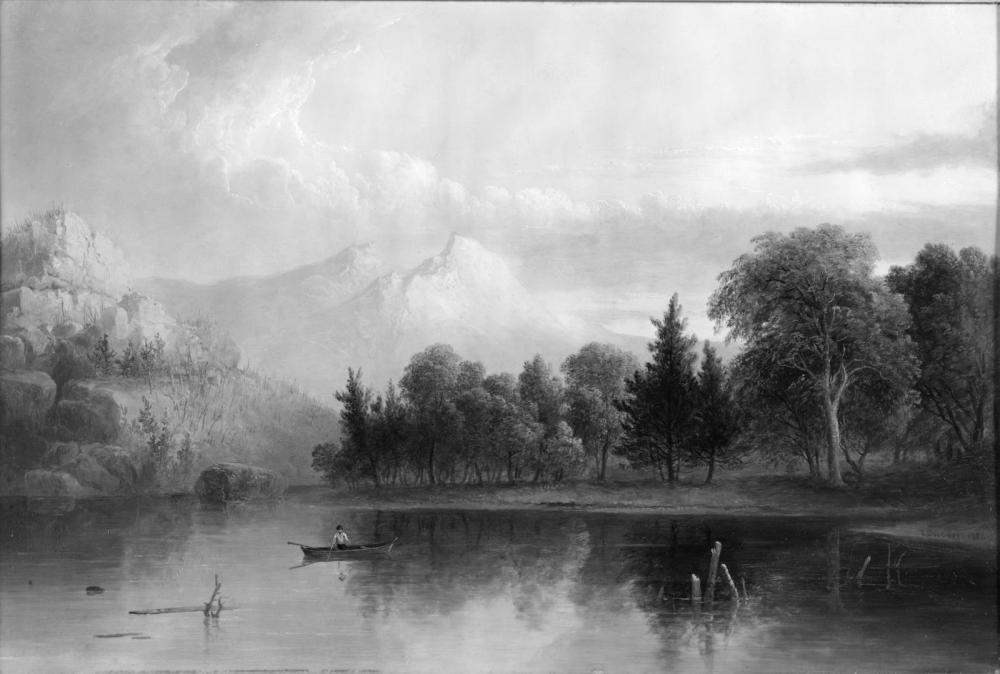Advanced Search 

Mountain and Lake
Thomas Doughty (American, 1791–1856)
1834
Medium/Technique
Oil on panel
Dimensions
40 x 58.42 cm (15 3/4 x 23 in.)
Credit Line
Bequest of Maxim Karolik
Accession Number64.408
NOT ON VIEW
CollectionsAmericas
ClassificationsPaintings
Thomas Doughty painted Mountain and Lake in 1834 during a particularly prolific period in his career. An idealized landscape scene, quiet and still, the composition is typical of Doughty’s mature work, when he began to produce paintings rapidly, keeping in mind the tastes of his most supportive patron, Robert Gilmor, Jr., of Baltimore, as well as those of his less discriminating middle-class buyers. Gilmor explained his preferences in a letter to the well-known American landscape painter Thomas Cole, whom he also patronized:
I differ with you in approving the omission of figures, which always give character & spirit even to solitariness itself . . . with a catching light or a red plume or mantle . . . [and would] assist the idea of solitude. [Frank H. Goodyear, Jr., Thomas Doughty 1793–1856; An American Pioneer in Landscape Painting (Philadelphia: Pennsylvania Academy of the Fine Arts, 1973), 22.]
Gilmor’s instructions are evident in Doughty’s composition. A man in a red vest fishes in placid and calm waters from a small boat. The mirrored surface of the lake reflects the snow-capped mountain peaks that dwarf the tiny fisherman and enhance the solitary mood. A large rocky outcropping at the left is studded with stunted trees, compositionally balanced by the dense forest of varied foliage and color on the right. Doughty’s angler is nestled within grandiose but confined scenery. While referring to the wilderness ideal, the majestic mountains that rise behind the fisherman are unlikely to be based on American scenery; instead, they are probably taken from Doughty’s romanticized notion of the topography of European mountain ranges. Doughty did not travel to Europe until 1837; nevertheless, he frequently used details such as these fantastical mountains to enhance the appeal of his paintings to an audience anxious to present a cosmopolitan and worldly aesthetic sensibility.
Naomi H. Slipp
I differ with you in approving the omission of figures, which always give character & spirit even to solitariness itself . . . with a catching light or a red plume or mantle . . . [and would] assist the idea of solitude. [Frank H. Goodyear, Jr., Thomas Doughty 1793–1856; An American Pioneer in Landscape Painting (Philadelphia: Pennsylvania Academy of the Fine Arts, 1973), 22.]
Gilmor’s instructions are evident in Doughty’s composition. A man in a red vest fishes in placid and calm waters from a small boat. The mirrored surface of the lake reflects the snow-capped mountain peaks that dwarf the tiny fisherman and enhance the solitary mood. A large rocky outcropping at the left is studded with stunted trees, compositionally balanced by the dense forest of varied foliage and color on the right. Doughty’s angler is nestled within grandiose but confined scenery. While referring to the wilderness ideal, the majestic mountains that rise behind the fisherman are unlikely to be based on American scenery; instead, they are probably taken from Doughty’s romanticized notion of the topography of European mountain ranges. Doughty did not travel to Europe until 1837; nevertheless, he frequently used details such as these fantastical mountains to enhance the appeal of his paintings to an audience anxious to present a cosmopolitan and worldly aesthetic sensibility.
Naomi H. Slipp
InscriptionsLower right: T DOUGHTY. 1834
Provenance1834, the artist. About 1937, Maxim Karolik, Newport, R.I.; 1964, bequest of Maxim Karolik to the MFA. (Accession Date: April 8, 1964)
